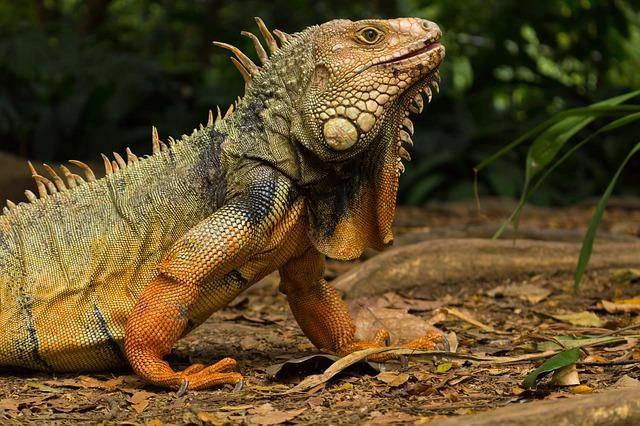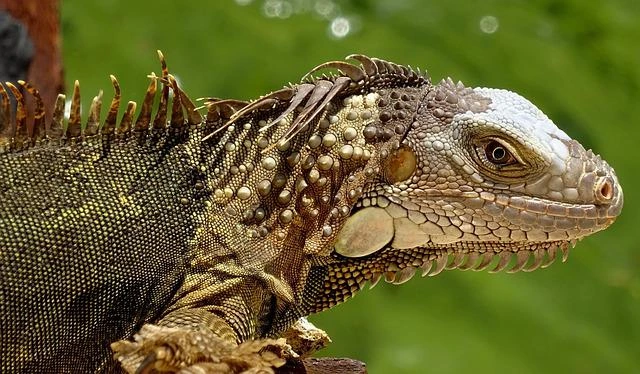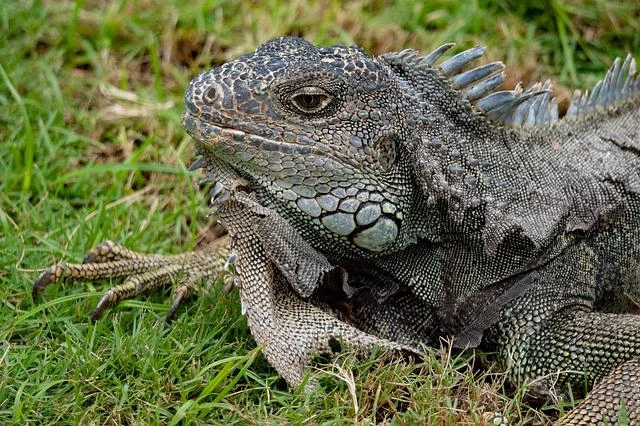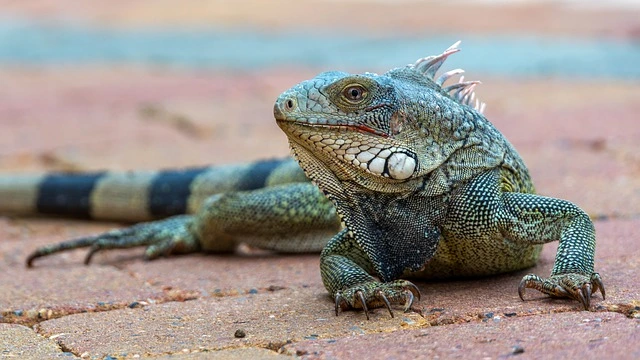Are Iguanas Aggressive? The Essential Guide Before Adopting Them.
If you are a fan of rare pets, then getting an iguana is probably on your bucket list. Iguana being such a large lizard, which can be kept as a pet, does pique one’s interest, but before you rush to your nearest pet store to get your own iguana, there are several aspects of keeping them as a pet that you need to consider, ranging from their diet, enclosure requirements, to the most important question that whether they can be safely kept as pets?
A Closer Look at Iguanas
Iguanas are one of the largest lizards, native to the tropic and subtropic climates, and are commonly found in Brazil, South America, and Mexico. In captivity, they can grow up to 5 to 6 feet long and weigh around 20 pounds. They have a long lifespan of around 15 years but can even live up to 20 years with proper care. Iguanas are cold-blooded, which means that they are incapable of maintaining their own internal temperature like a human, and that is why they need their enclosure’s temperature to be ideal for them, that is slightly warm, we will discuss more on their enclosure’s requirements later in the article.
The large size of an adult iguana and its inability to maintain its own internal temperature, are only a few of the reasons why getting a pet iguana cannot be an impulsive decision. Proper research and planning need to be done before getting one. In this article, we will look over all the aspects of caring for an iguana, the danger they might pose, and the safe ways you can interact with them.

Their Nature
Iguanas are not aggressive animals, it is not in their nature to attack; rather, in a situation where they feel threatened or cornered, they will choose to hide or flee. They have a reputation for being friendly and, more often than not, quite docile pets. An adult iguana will spend most of his time lazing around in his enclosure, basking in the sun, or taking naps. Pet iguanas take some time and practice to get accustomed to their owner’s touch and therefore need to be held often, which is safer for you if you get a baby iguana because you really don’t want to face the wrath of an adult iguana during the house-training process.
You mustn’t approach your iguana when he is sick, unless it is absolutely essential, as it is the nature of an injured iguana to attack because if they were in the wild, being injured would make them vulnerable and in that case, attacking is better than fleeing. Similarly, a male iguana is more likely to be aggressive than a female one, partly because of being territorial.
Your iguana will not attack you for no reason and will always show some signs before attacking, which we will look further into later in this article. Adopting a baby iguana and dealing with your iguana with patience, winning his trust over time, and learning his body language will ensure that you and your iguana are always on good terms with no unfortunate incidents.
Are Iguanas Aggressive? Or Dangerous?
Iguanas can harm a person in several ways, including:
1. Their sharp triangular teeth can cause severe lacerations to soft human skin in the unfortunate scenario where you annoy the iguana enough that he bites you. The good news is that their bite is not venomous to humans.
2. Their claws are quite sharp and capable of slashing the skin if the iguana swipes at you, although it is unlikely that the iguana will do that, due to their calm disposition.
3. The thing that you should be truly afraid of is the tail of an adult iguana, it is their most powerful weapon, capable of even breaking human bones. Granted, you would have to anger your iguana beyond reason to elicit such a reaction.
4. Iguanas carry the salmonella bacteria on their skin, as reptiles have salmonella bacteria in their intestine which causes their feces and consequently the iguana’s skin and enclosure to be contaminated with the bacteria too. It is not an acute threat to you, as long as you wash your hands after interacting with your iguana and refrain from kissing him.
If the Salmonella bacteria enters your bloodstream, it can cause several problems, including fever, diarrhea, vomiting, and chills.
As mentioned before, an iguana has no interest in harming humans and is not likely to attack just because you annoy your iguana slightly. But this does not mean that keeping an iguana is entirely risk-free, as iguanas are not domesticated animals like cats or dogs. During their training process and even later in their lives, the key to safely keeping an iguana is learning the signs that your iguana displays before attacking and stepping back as soon as he starts showing those signs.

Reasons Behind Aggressive Iguana Behavior and Precautions You Can Take
Despite the calm nature of iguanas, sometimes your iguana may display aggressive behavior. It can be due to several reasons including:
- Being territorial. While female iguanas can be territorial, the male iguanas have been reported to show a more territorial nature, when people enter their designated space.
- Iguanas are emotional animals, your iguana might be just stressed, hormonal, or angry on some days and it is better to leave them alone on those days.
- Breeding season can make the iguanas in captivity behave aggressively, lash out and cause them to be agitated and stressed.
- A large male iguana can be aggressive just because of his dominant streak, making him behave differently on day-to-day bases. Some days he can be absolutely docile crawling all over you while others, he won’t let you touch him.
Precautions When Handling Iguana
Pet iguanas, when they are not napping their afternoon away, like to climb on their owners, it is their way of cuddling. Due to their sharp claws, this affectionate act may leave you with scratches, to protect yourself from getting scratched and even for general protection when interacting with your iguana, some of the ways you can protect yourself are:
- Trim their nails regularly. Remember not to trim too much at a time, as you may hurt your iguana.
- Buy falconry gloves, even though they are expensive but getting those will help you safely interact with your iguana, especially in the beginning when they are more likely to attack.
- The best precaution against iguana attack is learning their body language, and always being on the lookout when interacting with your iguana. Some of the signs iguanas display before attacking are: standing rigidly on all four, puffing their body and trying to look larger, hissing or bobbing their head repeatedly, and/or lowering their dewlap which is the loose skin under their chin.

Housing And Caring for An Iguana
To properly welcome your iguana to his new home, you need to prepare appropriate resources to house him, feed him, and keep him warm. Some of the things you will need to keep your iguana content while you house him are discussed as follows.
Iguana’s Enclosure
When getting an enclosure for an iguana, don’t be mistaken by the small size of your baby iguana. Iguanas grow at a very fast pace and before you know it, your baby iguana would have grown from 10-20 inches at birth to roughly double the size in six months, and a foot every year till he reaches full size in about six years, that is six feet.
People make the mistake of getting an aquarium or reptile enclosure for their iguanas but that will only last your iguana for a year at max before they outgrow those enclosures. An iguana needs a large space to roam and climb on, as they are arboreal animals who prefer to climb and rest on trees. They tend to get territorial about their personal space, that is why they need a larger space, preferably a small room or an enclosure that is at least 10 feet in length, and six feet in width and height.
Their enclosure should be equipped with shelves, artificial branches, and ramps to satisfy their urge to climb as arboreal animals. You also need to keep their enclosure clean, regularly remove uneaten food, feces, and other waste, wash their food and water dishes daily, change their substrate once a week, and wash the enrichment stuff in their cage as well as the entire enclosure’s surface with a pet-safe cleaner at least once a month.
Things Required in An Iguana Enclosure
1. Maintaining the right temperature. Most iguanas that are kept as pets are from tropical climates, which means that if you want to keep an iguana, you will have to provide it an environment that is as similar to its natural habitat as possible, which in this case warrants the year-round temperature of their enclosure to be between 80 to 90 degrees Fahrenheit. You must keep the temperature optimum because the iguana can not survive the cold. You can use basking lamps or heaters to keep their enclosure’s temperature high.
2. Providing UVB light. Iguanas need to bask in the sun for around 10 to 12 hours a day, to promote the synthesis of vitamin D and calcium in their bodies, otherwise, they may suffer from calcium deficiency. In their enclosure, you can place UVB bulbs as a substitute for sunlight. Your iguana would like to bask lazily in these bulbs just as much, and these bulbs will ensure that your pet doesn’t suffer from any deficiency.
3. Maintaining high humidity. As the iguanas are habitual to high temperatures similarly, they have high humidity in the region they inhabit. Iguanas retain their water through their skin, and low humidity in their enclosure will cause them to lose water to the environment. You can maintain high humidity in their enclosure by misting their cage twice a day, or by simply installing a humidifier in their enclosure.
4. Substrate for their enclosure. An adult iguana will prefer to rest up on the ramps or branches you have installed in its cage, but it is still better to have some substrates cover the enclosure’s floor. You can use reptile carpet, recycled paper pallets, or butcher paper for substrate, just make sure that the substrate you use is non-toxic and easy to replace or clean.
What Do Iguanas Eat?
In the wild, some iguanas are omnivorous, eating both greens and occasional insects, while some are purely herbivorous surviving only on vegetables. In captivity, you should treat your iguana as strictly vegetarian. This is because consuming meat or cat /dog food can cause kidney issues and in severe cases, even full kidney failure in the iguanas, which ultimately results in the poor iguana’s death. Iguanas prefer to eat leafy vegetables, including iceberg lettuce, collard greens, green beans, turnips, asparagus, and almost all other green vegetables. They can also be fed occasional fruits like bananas, strawberries, and plums. You can also give them a pellet iguana diet besides the fresh vegetables.
Since iguanas grow so fast, they need loads of calcium and phosphorus in their diet to maintain healthy bones. You can easily get calcium and vitamin supplements from a vet that you should include in your iguana’s diet to keep him healthy. Keep in mind that those sharp scary teeth of your iguana aren’t actually going to help it chew its food, an iguana uses his teeth to just tear the food, therefore, you should chop anything that you are feeding your iguana into tiny pieces before giving to him.
Iguanas love water, it is good if you can get your iguana a small pool in its enclosure, but your iguana must always have fresh water available for drinking in his cage, you can also give your iguana an electrolyte solution. Wash his water dish daily when changing the water and remove any uneaten food by the end of the day.

Taming Iguana
When you adopt an iguana and bring him home, you should leave your iguana to his own device for a few days, do not try to interact with him. As the journey and the change in its environment can make the iguana unsettled and that makes him more likely to be on the defense and lash out when approached. Give your iguana a week or two to settle before approaching him, in the meantime, provide him with food and water daily.
After the two weeks, start the taming process by setting up a routine, as that will help your iguana feel relaxed and not intimidated by your presence. Feed your iguana the same time each day and set up a time and duration of your interaction with the iguana, same for every day. Remember, you need to pick up your iguana often in the beginning, for him to get used to you and your touch.
Talk to your iguana in a soft voice, and handle him gently, but do not let your iguana think that he is in charge as that may cause aggressive behavior. During the taming process, it is recommended that you hold your iguana as much as possible but don’t let your guard down as the iguanas have a strong self-defense instinct and they can harm you, if he feels threatened, no matter how docile he seems at other times.
Common Health Problems of Iguanas
- If the iguana’s enclosure is not maintaining the recommended temperature and humidity and is cold or dry, it can cause respiratory disease in the iguana.
- Due to poor hydration and low humidity of their enclosure, iguanas can become dehydrated, which causes kidney damage.
- Calcium and vitamin D deficiency is commonly found in pet iguanas due to the lack of basking lamps in their enclosure and the absence of calcium supplements in their diet.
- Their tails can fall off. The large tail falling off sounds scary, however, it is not unlike a tiny gecko’s tail falling off. An iguana’s tail can fall off if they face extreme stress or feel truly threatened. If your iguana’s tail falls off, there is no need to worry as the tail will grow back.
- As mentioned above, iguanas carry salmonella bacteria on their skin; therefore, proper hygiene should be maintained when interacting with an iguana. Always wash your hands after touching them or anything in their enclosure. Pregnant women, seniors, and children should refrain from touching iguanas entirely, as salmonella bacteria can be more damaging to them compared to other healthy adults.
Conclusion
Iguanas can be great pets for the right people and despite the danger of them harming you, with proper handling and knowledge you may never encounter any problem with your iguana. As discussed earlier in this article, caring for iguanas comes with its own responsibilities, some of which can be expensive like changing UVB bulbs every six months, or the constant year-round heater to maintain a warm environment in their enclosure. If you are prepared to put in the effort to tame your iguana and for the financial cost that will come with caring long term for an iguana, adopting an iguana is the right option for you, otherwise, it is better that you delay your decision until you are in the position where you can easily look after the iguana.

